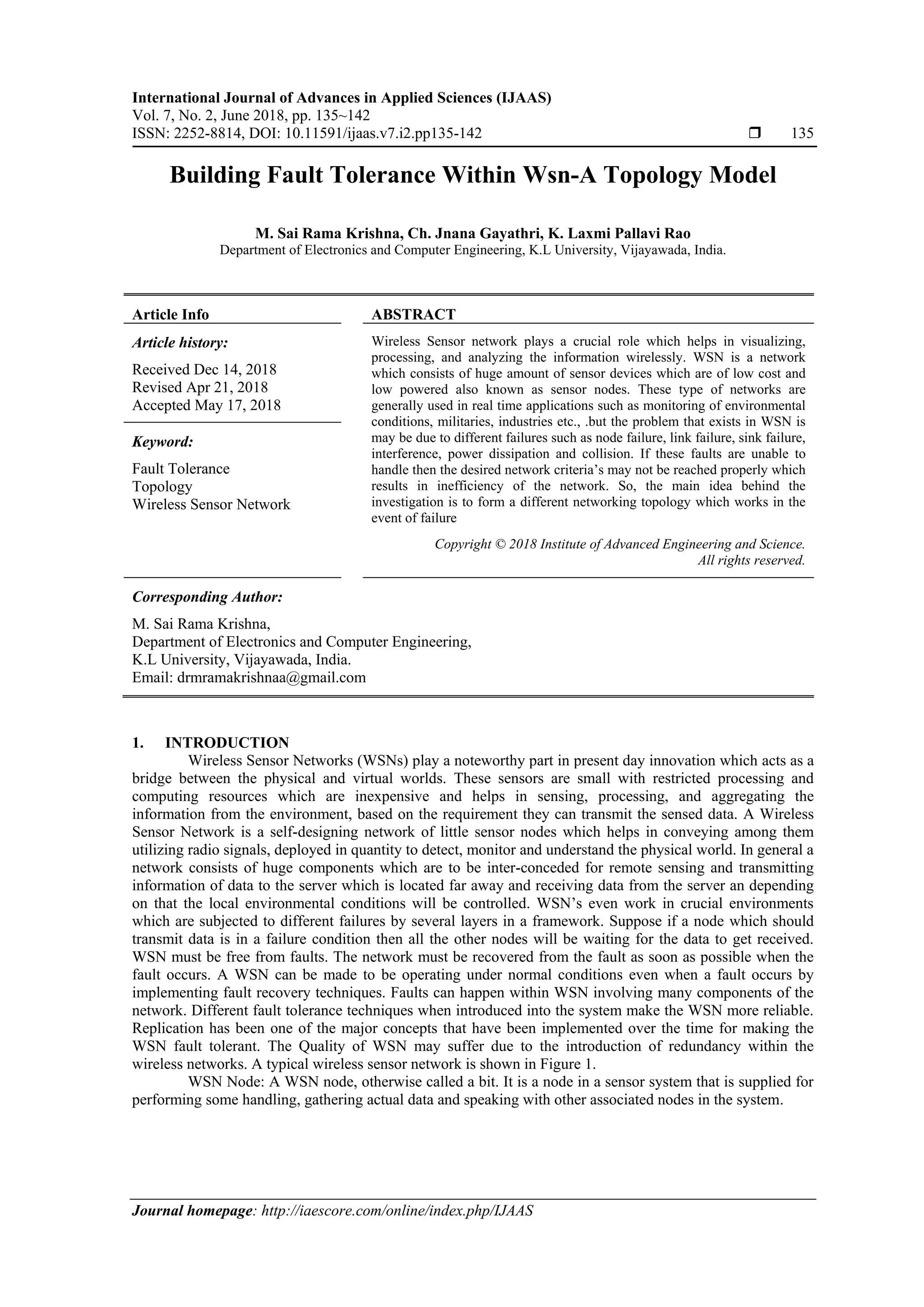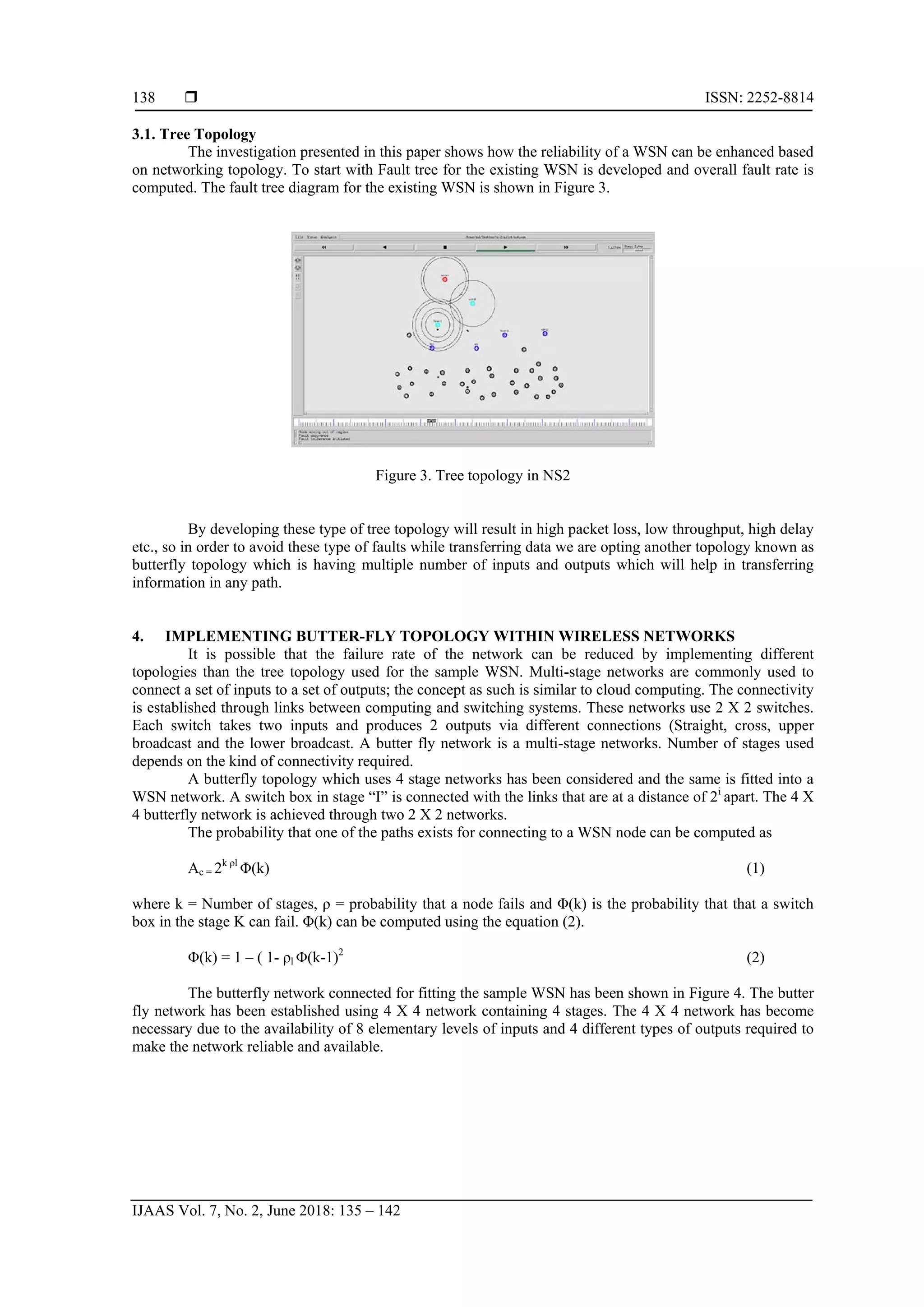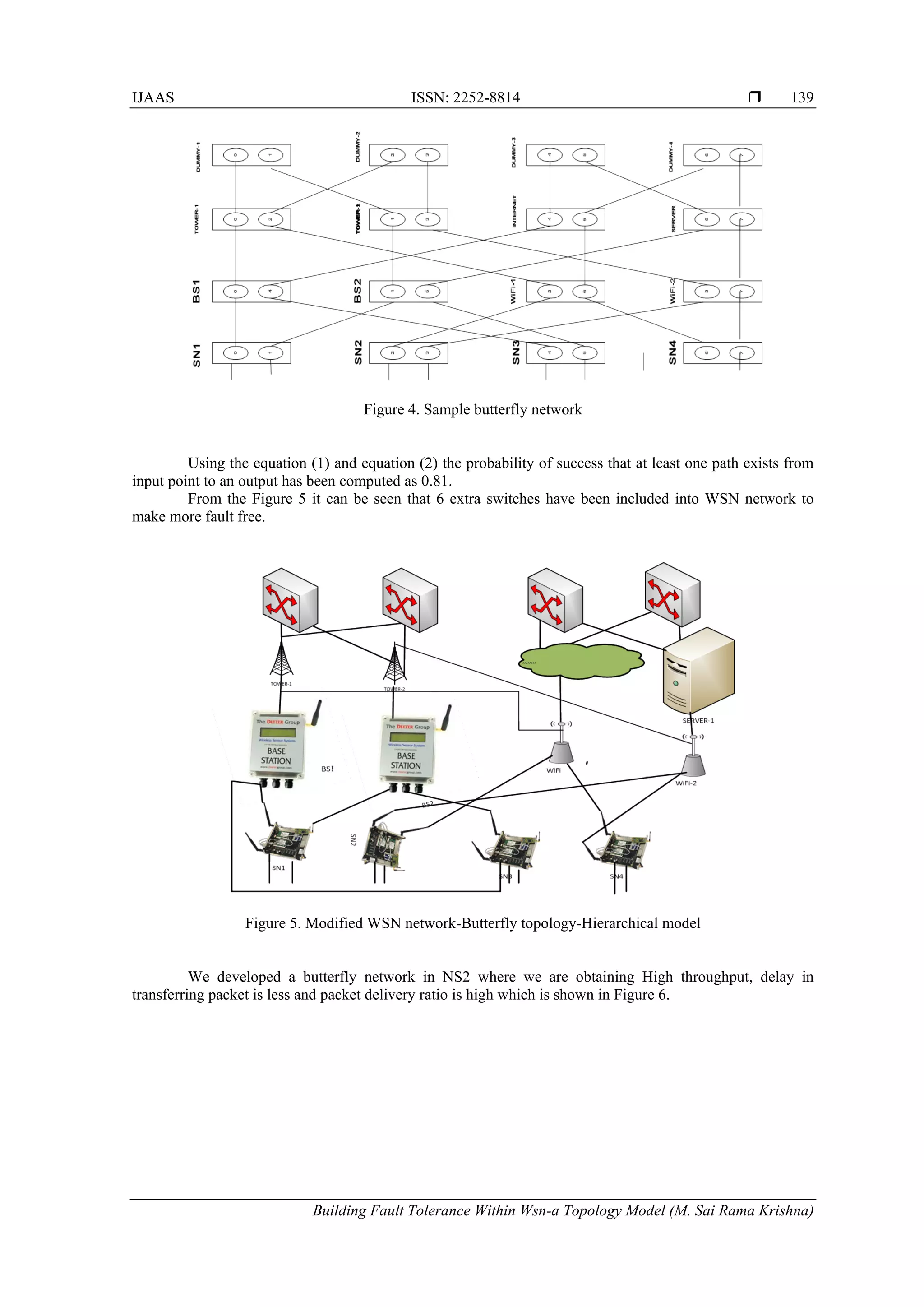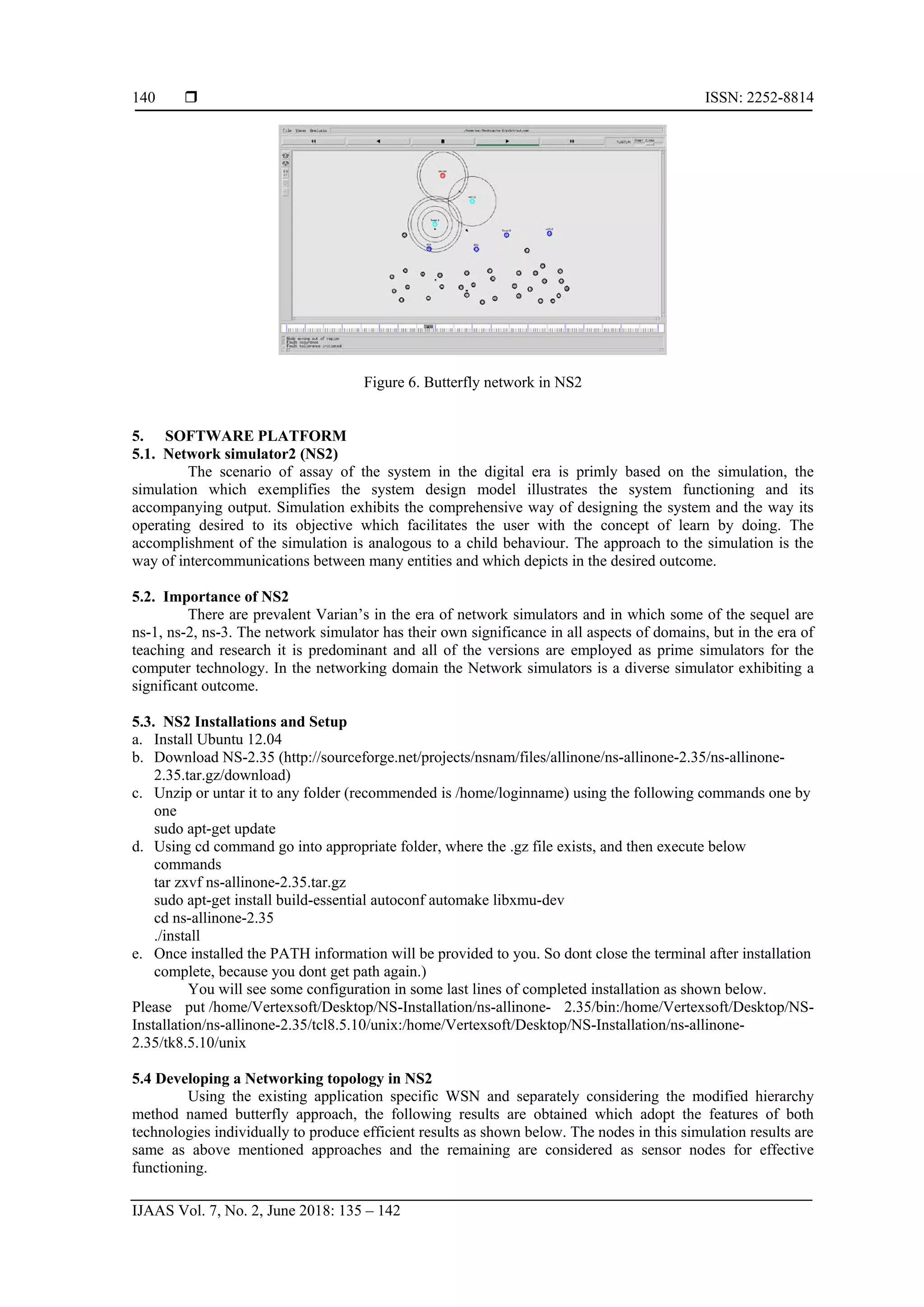This document presents a study on building fault tolerance within wireless sensor networks (WSNs) using different topology models. It discusses the need for fault tolerance in WSNs due to their susceptibility to various failures. The study analyzes existing tree topology-based WSNs and identifies issues like high packet loss. It then proposes a butterfly topology with multiple inputs and outputs to improve reliability. Simulation results in NS2 show that the butterfly topology provides higher throughput, lower delay, and higher packet delivery ratio compared to the tree topology. The document contributes towards making WSNs more reliable by implementing fault-tolerant topology designs.

![ ISSN: 2252-8814
IJAAS Vol. 7, No. 2, June 2018: 135 – 142
136
Figure 1. Typical WSN
Base station: The base station should perform computations; higher memory is required and is
frequently associated with better continuity source than batteries. One can look at the base station as an area
point to the WSN where the base station's fundamental target is to collect distinguished data strength nodes in
WSN. The main role of base station is to transfer the received data from nodes to the server.
Application server: Development and implementation of different applications which are related to
real time applications needs the use of Wireless Sensor Networks (WSN). The unique feature of these
applications is to use WSN to collect and process the information continuously
1.1. Characteristics of Wireless Senor Networks
WSN are characterized by many intricate issues which all have a bearing on its fault tolerance. Each
of the characteristics must be taken into account and analyzed to understand the effect of the same on its
behavior when any of the fault occurs. Some of the features that affect the fault tolerance behavior are as
shown below:
a. Ability to adapt to hub disappointment
b. Some portability of hubs
c. Heterogeneity of hubs
d. Adaptability to huge size of sending
e. Ability to withstand severe environmental conditions
f. Ease of utilization
g. Cross-layer plan
1.2. The need for building fault tolerance within WSN Networks
WSN are being used for many critical and mission critical systems, failure of which may sometimes
leads to disastrous situations and WSN lead to great losses in many forms. WSNs are being used for many
purposes which aircraft management, Vegetation, whether forecasting, Traffic management and control etc.
WSN are being used extensively for real life and real time data acquisition. The WSN networks are delicate
as the networks are established using tiny and fragile devices and generally quite prone for failures.
Therefore it is necessary that WSN are built considering the failures of the devices used for networking. It is
necessary to build as much fault tolerance as possible into WSN so that the networks can be made to work as
much reliably as possible.
1.3. Problem definition
There are various techniques exhibited in the realated work for increasing the fault tolerance of the
WSN network and none of the strategies presented have presented verifiability of the fault tolerance levels of
the WSN network. The problem is to discover the procedures, techniques and mechanisms utilizing which
the WSN can be made to be fault tolerant and verifiable. In this paper two techniques have been proposed
using which fault tolerance levels can be computed. The fault tolerance processed by both the methods
provides for verifiability of the Reliability of the WSN networks.
2. RELATED WORK
WSN are small devices, low cost, limited memory, low power, and low power consumption devices.
The main aim of the sensor networks is to provide reliability, maintainability, availability [1]. In general
there will be faults which may occur due to various factors such as node fault, sink fault, network faults.
Sushruta Mishra et, al., have expressed that WSN can be subjected to many faults and also provided an
overview on various fault detection and recovery systems which helps in continuing the operation normally](https://image.slidesharecdn.com/06-201022215502/75/Building-Fault-Tolerance-Within-Wsn-A-Topology-Model-2-2048.jpg)
![IJAAS ISSN: 2252-8814
Building Fault Tolerance Within Wsn-a Topology Model (M. Sai Rama Krishna)
137
in the event of some system component failures. The two methods used for fault recovery are Active
replication in which all or many nodes perform same functionality. If any node fails then also receiver will
get results from other nodes and the Passive replication involves Primary replica receiving all requests and
process them accordingly. Samira [2] described about routing solutions for fault tolerant which includes re-
transmission, in which the source node sends their data over an developed path, and if this path fails to
forward the data then the source again retransmits those data through different path. The second technique is
the data replication which sends different copies of the same data over multiple paths. Small scale sensor
networks which comprises of huge amount of sensors deployed over a small area which is based on Energy
and flow management in small scale WSN, Data management in small scale sensor networks and Coverage
along with connectivity in small scale networks while considering the Large Scale wireless sensor networks
(LS WSNs) which comprises of thousands of sensors are also based on various objectives of Energy and flow
management. C AHilaet [3] have presented automatic path recovery and efficient routing algorithms to make
the WSN fault tolerant. Fault tolerant multipath routing scheme for energy efficient wireless sensor network
(FTMRS) is based on multipath data routing scheme in which one of the shortest path is used for main data
routing and in the other two backup paths are used as alternative path for faulty network and to handle the
overloaded traffic on main channel. Manasvi [4] explained that wireless devices are battery powered for
maintaining protocols in an efficient manner. Flooding is a technique which continues until the destination
node is reached which results in impulsion or overlap. When same region is sensed by two sensors and the
sensed data is broadcasted at the same time, the neighbors will receive the duplicated packets which are
overcome by gossiping. In gossiping when a packet is received, a sensor would select one of its neighbors
randomly and send the packets to neighbor. This process continues until all sensors receive this packet but
there is a delay problem if the no of nodes get increased. Ting Yuan [5] presented the securing of the data
through introducing fault tolerance within WSN. The position of aggregating and forwarding the information
is known as sink. A node can't be each a sink and a source due to the fact this will substantially dissipate the
constrained power and security strength is a key management scheme, tamper-resistant hardware is still
economically mistaken to be applied in low-fee sensor nodes, making node capture even more appealing to
put into effect.
3. EXISTING WIRELESS SENSOR NETWORKS
A Wireless Sensor network is mainly used for continuous monitoring and processing the
information, in general there are so many existing WSN in which one of the applications is detailed in
Figure 2 which sprinkling of water and pesticide for turmeric plantation depending on the range of humidity
existence. After sensor sensing the existing humidity value then it initializes the sprinkling of water if it is
below the predefined. The entire data including date, time, humidity range, latitude and longitude, water
pumped are sent using base stations via internet to the main server. The data will be analyzed and if any
specific instructions required will be sent to the formers through SMS messages and the entire data received
will be stored at the main server. Connectivity of the main server and the base station is achieved through a
cable connection or using a combination of Wi-Fi/Cellular interface.
Figure 2. Existing WSN](https://image.slidesharecdn.com/06-201022215502/75/Building-Fault-Tolerance-Within-Wsn-A-Topology-Model-3-2048.jpg)




![ ISSN: 2252-8814
IJAAS Vol. 7, No. 2, June 2018: 135 – 142
142
Figure 9. Packet loss
The maximum numbers of packets are delivered in butterfly topology and minimum packets are
delivered in pilot sensor networks. The following displays the packet delivery ration in Figure 10.
Figure 10. Packet delivery Ratio
7. CONCLUSION
Fault tolerance within a WSN can be enhanced by way of adding redundancy at network level
requiring networking gadgets such as switches, bridges and gateways. The devices within the network when
connected using the butterfly like topology will enhance the reliability of WSN networks. Fault tolerance as
such can be included by way of creating as many paths as possible from a WSN node. In the case of butterfly
topology 3 paths are created from each of the node as 2X2 switches are used to switch the output from one
device to other.
REFERENCES
[1] Sushruta Mishra, Lambodar Jena, Aarti Pradhan “Fault Tolerance in Wireless Sensor Networks”, International
Journal of Advanced Research in Computer Science and Software Engineering, ISSN: 2277 128X, Volume 2,
Issue 10.
[2] C.Ahila Jerlin, N.Rajkamal “Fault Tolerance in wireless sensor Networks”, International Journal of Innovative
Research in Advanced Engineering (IJIRAE), ISSN: 2349-2163, Volume 2, Issue 2.
[3] Manasvi Mannan, Shashi B. Rana “Fault Tolerance in wireless sensor network”, International Journal of Current
Engineering and Technology, E-ISSN 2277 – 4106, P-ISSN 2347 – 5161
[4] SamiraChouikhi, InèsElKorbi, YacineGhamri-Doudane, LeilaAzouzSaidane “A survey on Fault Tolerance in small
and large scale wireless sensor networks” National School of Computer Science,
CRISTALLab,UniversityofManouba, Computer Communications 69 (2015) 22–37
[5] Ting Yuan, Shiyong Zhang “Secure Fault Tolerance in Wireless Sensor Networks” IEEE 8th International
Conference on Computer and Information Technology Workshops, 978-0-7695-3242-4/08 $25.00 © 2008 IEEE
DOI 10.1109/CIT.](https://image.slidesharecdn.com/06-201022215502/75/Building-Fault-Tolerance-Within-Wsn-A-Topology-Model-8-2048.jpg)